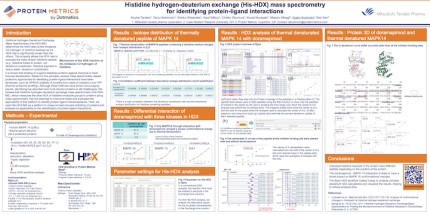His-HDX MS for Protein-Ligand Interaction Identification
Histidine hydrogen-deuterium exchange (His-HDX) mass spectrometry identifies protein-ligand interactions.
About This Poster
Histidine Hydrogen-Deuterium Exchange Mass Spectrometry (His-HDX-MS) determines the HDX rates at the imidazole C2-hydrogen of histidine residues as it’s HDX rate is significantly slower than the others. This property allows the HDX rate to evaluate the state of each histidine residue. (e.g. Histidine folded in protein: not deuterium substituted. Histidine exposed to heavy water: deuterium substituted).
It is known that binding of a ligand stabilizes proteins against chemical or heatinduced denaturation. Based on this principle, several mass spectrometry-based proteomic approaches for identifying protein-ligand interactions have been developed, such as SPROX (stability of proteins from rates of oxidation) and TPP (thermal proteome profiling). Although these methods have shown encouraging results, identifying low abundant and multi-domain proteins is still challenging. We foresee that histidine hydrogen-deuterium exchange mass spectrometry (His-HDXMS), which measures the slow HDX of histidine imidazole groups in proteins using mass spectrometry, has the potential to overcome these and evaluated the applicability of this platform to identify protein-ligand interadrawbacks. Here, we used His-HDX-MS as a platform to measure heat-induced unfolding of proteins and evaluate its applicability to the identification of protein-ligand interactions.















